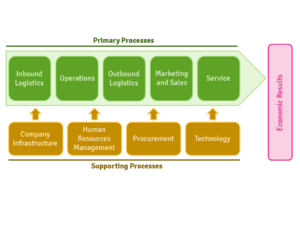Added value chain: Difference between revisions
(Infobox update) |
|||
| Line 19: | Line 19: | ||
==Primary activities== | ==Primary activities== | ||
[[File:added_value_chain.png|300px|right|thumb|Fig.1. Added value chain (based on M. Porter, 1985)]] | |||
According to the model primary activities consist of: | According to the model primary activities consist of: | ||
* Entry [[logistics]] (warehousing, sorting, inventory, [[quality]] control, and overall supply support), | * Entry [[logistics]] (warehousing, sorting, inventory, [[quality]] control, and overall supply support), | ||
| Line 26: | Line 27: | ||
* After-sales [[service]] (support for the [[finished product]], such as installation, repair of warranty). | * After-sales [[service]] (support for the [[finished product]], such as installation, repair of warranty). | ||
In [[service]] company a string of activities will reflect how to perform a certain [[service]] for customers. | In [[service]] company a string of activities will reflect how to perform a certain [[service]] for customers. | ||
==Support activities== | ==Support activities== | ||
Revision as of 09:09, 27 August 2020
| Added value chain |
|---|
| See also |
The concept of value added chain developed by Michael Porter presents a business as a string of related activities in a logical whole, taken at the time of manufacture of the product manufactured or service, leading to added value for company and customer. The author indicated two types of activities: primary activities and support activities.
Primary activities are directly related to the production of the final product or service and their sale. This is the basic process going through the whole enterprise, including physical production, sale, provision, and support for the product on the market.
Primary activities
According to the model primary activities consist of:
- Entry logistics (warehousing, sorting, inventory, quality control, and overall supply support),
- Operations (manufacturing of the product),
- Departure Logistics (warehousing, sorting, inventory, quality control, and support the sale of the products),
- Marketing and sales (market research, elements of the marketing mix and sales),
- After-sales service (support for the finished product, such as installation, repair of warranty).
In service company a string of activities will reflect how to perform a certain service for customers.
Support activities
Support activities and operations are similar in every type of business. Support activities consist of:
- Enterprise infrastructure management (maintaining the efficient operation of the company, including management, accounting, etc.),
- Human resource management,
- Changes in technology (development, finding new solutions),
- Purchase (purchase of raw materials and consumables, as well as measures to support purchases).
Management tasks
Goal of management is the effective use of knowledge flowing from the developed model, to make optimal decisions about costs of individual activities, which in turn affect the efficiency of the company, its total costs and profit margins. In addition, managers need to optimize and coordinate relations between the links of the chain in order to gain a competitive advantage. It is possible to achieve by using:
- Internal coordination of activities within the company, to improve elementary operations and reduce their costs,
- External coordination for improving the relationship between suppliers and customers.
Reporting value chain costs
Measurement and presentation in the financial statements of costs associated with the operations of the product contained in the chain is called the "Bill of the cost of the value chain". However, the identification and measurement of costs for each phase is often a very difficult task, for example: the costs of research and implementation of product and marketing are hard to measure. Therefore, it is vital to develop an efficient system for recording costs, which will ensure the assignment of the cost to a particular product or service. Analysis of the value chain is an important tool for assessing vulnerabilities and strengths of the company or make decisions about possible alliances and mergers.
References
- McPhee, W., & Wheeler, D. (2006). Making the case for the added-value chain. Strategy & Leadership, 34(4), 39-46.
